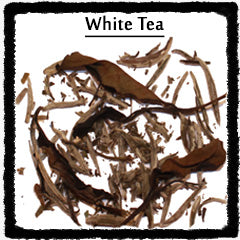99% Pure
 White tea is just one step above raw tea, and was the first type of tea created for storage. It is incredibly delicate and strict measures are undertaken to ensure the quality of leaves to be processed. Imperfect and low-quality leaves are easily recognizable due to the minimal amount of processing. The younger sprouting of tea leaves - the bud and two leaves (pekoe and above) - are usually prime choice for white tea. The younger leaves are rich in nutrients and flavonoids, creating a potent tea for multiple infusions.
White tea is just one step above raw tea, and was the first type of tea created for storage. It is incredibly delicate and strict measures are undertaken to ensure the quality of leaves to be processed. Imperfect and low-quality leaves are easily recognizable due to the minimal amount of processing. The younger sprouting of tea leaves - the bud and two leaves (pekoe and above) - are usually prime choice for white tea. The younger leaves are rich in nutrients and flavonoids, creating a potent tea for multiple infusions.
Like green, oolong, and black teas, white tea is a product of the camellia sinensis plant. When brewed, it produces a delicate, sweet flavor with a light-colored liquor and contains a very low amount of caffeine; therefore, it’s a great balance for those sensitive to caffeine but still looking to receive all the benefits of tea. Due to harvest and processing methods, however, some rare white teas can have just as much caffeine as a rare green or black tea. Eli Tea will be sure to alert you if that is the case with any of our teas, but again, it is safe to assume the majority of white teas are caffeine-free or low in caffeine.
|
Energizing Power Hierarchy White<Green<Oolong<Black<<Coffee<Mate
White Tea Caffeine Level: 1-5 mg per 6 oz cup Coffee Caffeine Level: 100-120 mg per 6 oz cup Note: These caffeine levels are industry standard averages |
Production
Three important stages of white tea production are enzyme kill, withering, and drying. White tea can undergo two distinguishable pathways of processing from these steps:
1) The freshly harvested tea leaves are rushed to micro-factories to undergo the enzyme kill stage where they will be heat-treated to stop oxidation. The leaves are then allowed to wither for some time before undergoing a final drying stage.
Harvest leaves > enzyme kill > withering > drying
2) The freshly harvested leaves are dried out on mats for 1-3 days in sunlight, indoors, or possibly in the dark. They then undergo the enzyme kill stage, in which they are heat-treated to stop oxidation. The leaves then briefly rest before a final drying.
Harvest leaves > extended withering > enzyme kill > drying
Brewing
White teas also have two unique ways of brewing:
1) High temperature, low time brew:
Steep tea leaves in near-boiling water (210°F) for 30 - 45 seconds and then remove promptly.
2) Low temperature, slow brew:
Steep tea leaves at 170-180°F (sometimes lower) for 3 - 10 minutes.
In the tea world, you will also find that white teas especially have many variations in the amount of time and the temperature at which to brew. The different methods of brewing create different flavor profiles and also release different nutrients and antioxidants. Brewing tea at higher temperatures, however, can be potentially damaging to some antioxidants. A reliable way to brew just about any white tea is at 180°F for 3-5 minutes.
Health Benefits
Skin health
High levels of antioxidants, especially catechins
Wrinkle reduction
Antibacterial compounds
Trending Research studies

 White tea is just one step above raw tea, and was the first type of tea created for storage. It is incredibly delicate and strict measures are undertaken to ensure the quality of leaves to be processed. Imperfect and low-quality leaves are easily recognizable due to the minimal amount of processing. The younger sprouting of tea leaves - the bud and two leaves (pekoe and above) - are usually prime choice for white tea. The younger leaves are rich in nutrients and flavonoids, creating a potent tea for multiple infusions.
White tea is just one step above raw tea, and was the first type of tea created for storage. It is incredibly delicate and strict measures are undertaken to ensure the quality of leaves to be processed. Imperfect and low-quality leaves are easily recognizable due to the minimal amount of processing. The younger sprouting of tea leaves - the bud and two leaves (pekoe and above) - are usually prime choice for white tea. The younger leaves are rich in nutrients and flavonoids, creating a potent tea for multiple infusions. 
